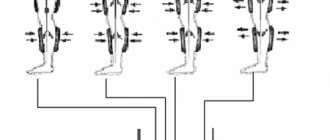Causes of anemia
In the vast majority of cases (up to 90%), anemia is caused by iron deficiency. Iron is part of hemoglobin and is involved in the process of hematopoiesis. Iron-deficiency anemia
occurs when there is insufficient consumption of iron-containing foods (primarily meat and vegetables). Anemia can also occur with the right diet, for example, if iron is not absorbed by the body due to existing problems with the gastrointestinal tract. Blood loss can also contribute to the development of anemia. However, blood loss does not have to be large. Frequent nosebleeds, bleeding gums, hemorrhoids, and heavy periods can cause anemia.
Possible causes of anemia include a lack of vitamin B 12 or folic acid, but these types of disease are much less common. Hemolytic anemia is also isolated, characterized by increased (faster) destruction of red blood cells.
Anemia can be genetically determined, that is, it can be hereditary.
Anemia: how to diagnose and treat
Anemia is a clinical and hematological syndrome in which the level of hemoglobin, red blood cells and hematocrit decreases. Anemia is diagnosed when the hemoglobin level decreases to less than 117 g/l in women and less than 132 g/l in men. It is necessary to understand that anemia is not an independent disease, but a syndrome that develops with a large number of different diseases, can be a manifestation of a combination of various pathologies and requires a deep diagnostic search. Anemic syndrome is widespread - certain types of anemia occur in 10-20% of the population around the world, and any groups of people can be affected, regardless of gender, age, region of residence, or work activity. Women (especially during pregnancy) and children are most susceptible to anemia. The most common cause of anemia is iron deficiency (about 80-90% of all anemias) or other vitamins and microelements. Slightly less common are anemia that accompanies chronic diseases associated with impaired hemoglobin production in the bone marrow or its accelerated destruction, and hereditary anemia (which is more typical for residents of the countries of the Mediterranean basin and equatorial Africa).
Causes and risk factors for anemia
The immediate causes of anemia may be:
1. Insufficient intake of vitamins and microelements - this group includes anemia, which develops as a result of a decrease in the intake of substances into the body that are necessary for the creation of hemoglobin and red blood cells. These substances include iron and folic acid; their deficiency is most common and is associated with dietary habits - complete or partial refusal of meat foods, prolonged fasting.
2. Anemia due to blood loss (posthemorrhagic) - can be both acute (in case of severe injuries) and chronic. In chronic posthemorrhagic anemia, bleeding does not occur simultaneously in large volumes, but over a long period of time and in small portions. Such anemia is typical for diseases of the gastrointestinal tract (hemorrhoids, anal fissure, chronic inflammatory bowel diseases), and the genitourinary system (acute and chronic glomerulonephritis, urinary tract infections, urolithiasis, kidney cancer).
3. Anemia caused by deterioration in the functioning of hematopoietic organs and systems is associated with disruption of the normal functioning of the bone marrow, in which it does not produce a sufficient number of cells. This type of anemia develops both with primary damage to the bone marrow (in the presence of an oncohematological disease) and against the background of exposure to toxic substances (most often drugs, but also poisons and heavy metals).
4. Anemia of chronic diseases – occurs in patients with long-term chronic inflammatory and non-inflammatory diseases. They are associated both with dysfunction of certain organs that affect the maintenance of normal levels of hemoglobin or red blood cells in the body (for example, a decrease in the functional activity of the kidneys against the background of diabetes mellitus, arterial hypertension, which leads to a decrease in the production of erythropoietin, a hormone that stimulates the growth of red blood cells), and and with an increase in the synthesis of hepcidin, a protein that reduces iron absorption, characteristic of inflammatory processes.
Clinical manifestations of anemia
At the initial stage of anemia, when the decrease in the level of hemoglobin, red blood cells or hematocrit occurs gradually, a person may not notice the presence of any changes, attributing them to fatigue, heavy physical or mental work, or weather conditions. In addition, at the initial stages of the development of anemic syndrome, people adapt to the changing state of the body, reducing their physical activity, which leads to masking of anemia.
The complaints made by patients with anemic syndrome are nonspecific and require a clear and complete history. Most often, people note general weakness and decreased tolerance to physical activity, which was previously considered adequate for them. Patients note a general decrease in performance, headaches, dizziness, drowsiness, shortness of breath during normal physical activity (climbing stairs or long walking on a flat surface). With further progression of anemia, loss of consciousness, disturbance of the sleep formula, an increase in temperature to subfebrile values (37-37.5 C), indigestion, weight loss, episodes of rapid heartbeat or pain in the left half of the chest during physical activity are observed.
During examination, it is necessary to pay attention to changes in the color of the skin and mucous membranes, which become significantly paler as the anemia further worsens. Also, the skin can become dry, cracks easily appear on it, hair falls out and becomes brittle. The nail plates change - they become thinner and flatter, can break easily, and become concave. When auscultating the heart of a patient with anemia, the doctor notes the presence of a specific “systolic murmur.”
The above changes are not enough to establish an accurate diagnosis and select therapy, but each person can identify most of them independently and consult a doctor to determine the causes of such changes in their health and carry out further measures for diagnosis and selection of therapy.
Methods for diagnosing anemia
If you identify one or more of the above symptoms, you must consult a doctor to clarify the presence of anemic syndrome and determine its causes. This process occurs in several stages:
• detection of anemia; • determination of the severity of anemia; • detection of the causes of anemia.
Taking into account the variety of causes that can cause anemia, a large number of studies are carried out in the diagnostic search - examination by a doctor with the collection of complaints and clarification of facts from the patient’s medical history, conducting laboratory and instrumental studies and, if necessary, prescribing consultations with specialists. Only a doctor can select the necessary list of diagnostic methods and interpret them correctly.
The presence of anemia in blood tests is primarily indicated by a decrease in indicators such as hemoglobin, red blood cells and hematocrit. Since these indicators are interrelated, most often they decrease simultaneously, but in some situations only one indicator may be reduced, which also indicates the need for a doctor’s examination and further research. Based on the results of a general clinical blood test, the doctor can make a conclusion about the severity of anemia, suggest its genesis and decide on further tactics - whether there is a need for emergency hospitalization of the patient or whether examination and treatment can be continued on an outpatient basis.
Based on the results of a biochemical blood test and a general urine test, the doctor can more accurately determine the cause of anemia (for example, a lack of any microelements or signs of hemoglobin destruction) and, having ruled out other causes, can prescribe therapy to correct these changes. Since anemia is a multifactorial disease, its diagnosis may require the use of instrumental research methods, depending on which version of the origin of anemia in the patient (taking into account the available data) the attending physician adheres to. This may include methods such as radiography, ultrasound examination of organs, and endoscopic examinations. With the help of the studies, the doctor will be able to accurately determine the cause of anemia, determine the presence of diseases that can lead to it and, if necessary, refer the patient for consultation to a specialist corresponding to the profile of the identified disease.
Directions of treatment
In the treatment of anemic syndrome, 2 goals are pursued: correction of indicators to achieve normal functioning of all organs and systems and elimination of the factor that led to the development of anemia (i.e. treatment of the underlying disease, correction of deficiency of vitamins or microelements).
Taking into account the identified causes of anemia, therapy can use preparations of vitamins and microelements (in the form of tablets or in the form of intravenous or intramuscular injections), therapy of chronic diseases, if their course is the cause of anemia, resolving the issue of consultations with specialists of the necessary profile and surgical treatment for indications.
If there are clinical signs of anemic syndrome or deviations from the norm identified in the tests, you should under no circumstances self-medicate. The doctor will be able to prescribe the necessary therapy only after conducting a series of examinations and determining an accurate diagnosis.
Independent, uncontrolled use of drugs can aggravate a person’s condition, since it may not affect the cause of anemia or simply temporarily mask it behind a short-term improvement in the condition. In addition, each drug has contraindications and side effects, so therapy, taking into account the individual characteristics of the patient, can only be selected by the attending physician.
Symptoms of anemia
Lack of hemoglobin leads to oxygen starvation, manifested by symptoms typical of anemia such as:
General weakness
With anemia, muscle tissue does not receive sufficient nutrition. The patient feels constantly tired, he does not have enough strength for normal life activities.
Drowsiness
The body lacks strength, which means it needs additional rest. Drowsiness develops. A person suffering from anemia is almost never alert; as a rule, he wants to sleep.
Pallor
Pale skin due to anemia is caused by a decrease in the number of red blood cells (erythrocytes) in the blood.
Dizziness
With anemia, the brain also receives insufficient nutrition. This may cause dizziness.
flickering
The flickering of “flies” before the eyes is caused by insufficient nutrition of the structures of the visual apparatus.
Fainting
If the decrease in hemoglobin is significant, fainting is possible - episodes of loss of consciousness.
Headache
With anemia, headaches are often observed.
More about the symptom
Cardiopalmus
You may experience palpitations with little physical activity or at rest.
More about the symptom
Dyspnea
Shortness of breath with anemia is caused by the fact that the body tries to compensate for the lack of oxygen by increasing its supply. Breathing becomes more frequent.
More about the symptom
Average degree
With iron deficiency anemia, in most patients the decrease in Hb is relatively moderate (up to 85 - 114 g/l), much less often a more pronounced decrease develops - up to 60 - 84 g/l. Anemia at this stage can manifest itself with the following clinical symptoms:
- weakness, fatigue;
- shortness of breath, palpitations on exertion;
- dizziness, darkening of the eyes when standing up quickly and in a stuffy room;
- pulsation in the temples, neck;
- headache;
- possible weakening of attention, memory deterioration, decreased mental performance;
- the course of coronary heart disease becomes more severe;
- pallor of the skin and mucous membranes.
In some patients with iron deficiency anemia, a connection with restless legs syndrome is described. It is characterized by the need to move the legs due to a feeling of discomfort that arises in them, mainly in the evening and at night. The appearance of palpitations will characterize the transition to the stage of severe anemic syndrome.
Methods for diagnosing anemia
Anemia is diagnosed based on laboratory tests.
General blood analysis
A complete clinical blood test is the basic test for determining anemia. For a more detailed diagnosis of certain types of anemia, additional studies may be prescribed.
More information about the diagnostic method
Sign up for diagnostics To accurately diagnose the disease, make an appointment with specialists from the Family Doctor network.
Anemia Treatment Methods
Treatment of anemia is aimed, first of all, at identifying and eliminating the cause of the disease. In case of detected iron deficiency (vitamin B12, folic acid), replacement therapy is carried out with drugs that compensate for this type of deficiency. A special diet high in essential substances is also prescribed.
Doctor visit
If you are concerned about weakness, dizziness, drowsiness and other symptoms that suggest anemia, we recommend that you consult a general practitioner or family doctor at any of the clinics of JSC “Family Doctor”. The high professionalism of our specialists and modern equipment allow us to effectively treat anemia, including during pregnancy, breastfeeding and other periods that require a special approach.
Make an appointment Do not self-medicate. Contact our specialists who will correctly diagnose and prescribe treatment.
Rate how useful the material was
thank you for rating
Prevention of anemia - which foods contain iron
My children and I are vegetarians. From what plant products can we get iron to prevent anemia?
In fact, it is easier for meat eaters to maintain optimal iron levels in the body. And not because vegetarian food is poor for them. On the contrary, there is a lot of iron in plant products: buckwheat, dried fruits, beans, parsley, oatmeal, millet, dried mushrooms, honey, seaweed. However, such iron (trivalent) is poorly absorbed. First, it needs to be converted in the body into a divalent form (this is exactly the iron found in meat). And for those who have reduced stomach acidity (for example, anacid gastritis), iron from plant foods is not absorbed at all.
In addition, when consuming foods that are sources of iron, it is important to avoid simultaneous consumption of foods that impair the absorption of this mineral. These are, first of all, dairy products, strong tea and coffee - calcium and tannins interfere with absorption. But cocoa or a little dry white wine, on the contrary, helps. But the easiest way to keep iron under control is by eating meat. And as a side dish, choose vegetables rich in vitamin C. Ascorbic acid increases iron absorption.
For vegetarians, it is better to work with your doctor to select the optimal form and dose of iron supplements to prevent anemia. You should not take iron supplements uncontrollably. Iron overload leads to congestive heart failure, liver and kidney damage. In addition, there are diseases for which iron intake is undesirable. This is inflammation of the pancreas, stomach ulcers, intestinal diseases, exacerbation of infections.
It is especially important to monitor and, if necessary, regulate iron levels for expectant mothers. It is necessary to respond urgently if signs of anemia appear during pregnancy. This will prevent the development of gestosis, premature birth, malformations in the fetus and many other problems for the mother and newborn.




![Rice. 1. ACCOMPLISH study: the effect of the combination of ACE inhibitor* amlodipine and ACE inhibitor hydrochlorothiazide on the risk of primary endpoint events (CVE) [14]](https://expert35.ru/wp-content/uploads/ris-1-issledovanie-accomplish-vliyanie-kombinacii-iapf-amlodipin-i-iapf-330x140.jpg)

